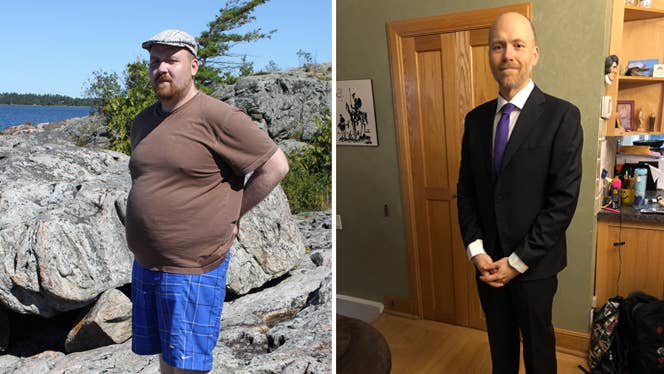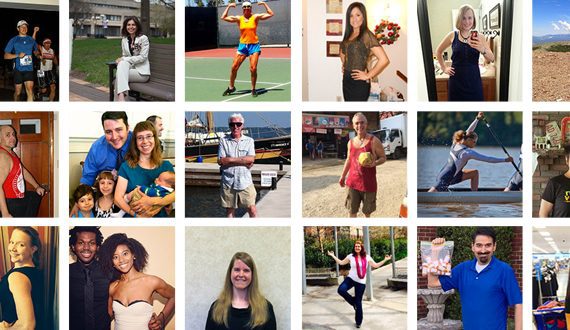
On a Whole-Food, Plant-Based Diet, I’m Staying Fit Without Counting Calories
By Jeremy LaLonde,
In high school I was an athlete. I was used to consuming lots of calories; I was burning them off just as fast. When I stopped playing sports, I didn’t change my eating habits, and it didn’t take long to get up to 360 pounds. My focus was always on my career. My health just wasn’t a priority. Every now and then I’d have an urge to get healthier, but I’d always find an excuse not to.
Discovering the Whole-Food, Plant-Based Way of Eating
I got married and had kids, and as they got older, I noticed how out of shape I was: I couldn’t even keep up with toddlers! They started making observations about “Daddy’s weight.” I wanted to be a role model for them and to have more energy, and I knew that the older I got, the harder it would be for me to lose weight. I was already a vegetarian at that point—a direct result of having watched the documentary Forks Over Knives—but I hadn’t gone completely plant-based yet. Then I started reading more about other people’s weight-loss journeys, and I discovered doctors like Joel Fuhrman, MD, and Michael Greger, MD. That’s when the world of whole-food, plant-based (WFPB) eating opened up for me!
Finding a Balance
Once I had my mind in the right gear, I decided to devote at least 30 minutes a day to movement. I came up with some exercise routines that I could fit into my days and found excuses to walk as much as possible. I combined the fitness with calorie-counting and found that the weight just started to fall off. I lost around 8 pounds a month for over a year. As I started to get toward a healthier weight, I found myself hitting a plateau. But soon I discovered intermittent fasting. I’d always had a bad habit of having late-night snacks, and that stopped it in its tracks. I stopped eating after my last meal of the day and didn’t eat again until after I had my morning workout. The weight started to come off again.
Eventually, I got down to my goal weight of around 160 pounds—200 pounds less than I was at my heaviest—but there was a problem: I was addicted to calorie-counting. If I’m honest, it made me feel a bit controlling, and I found that it was turning me into a kind of person that I didn’t want to be. After a heart-to-heart with my wife, I realized that there was no need for me to continue counting my calories, especially since I was eating entirely whole-food, plant-based by that point, and everything I was reading was saying that calorie-counting wasn’t necessary. So I stopped, cold turkey, and I promised myself I’d weigh in only once a week.
I ended up gaining some weight back, which upset me at first, but eventually I realized that I had actually overdone it with the weight loss before. So the next year was about finding a balance—eating properly, moving regularly, and figuring out what my natural body weight should be.
Staying the Course
Today I sit around 200 pounds without having to try that hard at all. I make time in my day for movement, eat when I’m hungry, and never worry about portions, because the food I’m eating is good for me.
I love making delicious plant-based comfort foods. When the COVID-19 pandemic hit, I filled some of the time with Rouxbe online cooking courses and took my culinary skills up a level. I was bursting with ideas and new recipes that my family and friends were loving just as much as I did. They were shocked that they were all WFPB.
Throughout this process a lot of friends and family started asking me how I’d so drastically improved my health. I realized that many people out there just didn’t have the right information. So I started to talk about my transformation on social media, and I now have a plant-based cooking series on YouTube. I can’t wait to see where this plant-based journey takes me next. I feel like I’m just getting started!
My Tips for Winning Over Friends and Family with WFPB Dishes
When friends or family come over, I like to stack their plates with comfort-food goodness that’s so delicious they don’t even think about the fact that it’s WFPB. Here are a few things I’ve found to be effective.
Texture Helps: Don’t underestimate mouthfeel when building your dishes! For instance, when making something like a grain bowl or salad, try adding a little crunch with a sprinkling of nuts, seeds, tortilla chips, or shredded cabbage.
No Faux: Omnivores know what animal products taste like. Instead of trying to fool them with highly processed vegan “meats” and “cheeses,” I fill them up with healthy homemade plant-forward faves like taco soup, falafel, or lentil stew and mash.
Sweet Spot: It’s easy to come up with naturally delicious desserts when there are so many simple baking swaps: flax eggs in place of regular eggs, fruit purees instead of oil, dates or pure maple syrup instead of refined sugar. The omnivores in my life can’t get enough of my fruit cobbler, avocado-banana brownies, or chickpea cookie dough—and they can never believe the goodies are WFPB!
Ready to get started? Check out Forks Meal Planner, FOK’s easy weekly meal-planning tool to keep you on a healthy plant-based path. To learn more about a whole-food, plant-based diet, visit our Plant-Based Primer.
Has a whole-food, plant-based diet impacted your life?
We would love to hear about it!
SHARE YOUR STORY
Free Download
Free 5-day meal plan!
Get a taste for healthy, fuss-free meal planning with this free five-day meal plan from Forks Meal Planner!
By providing your email address, you consent to receive newsletter emails from Forks Over Knives. We value your privacy and will keep your email address safe. You may unsubscribe from our emails at any time.

Join our mailing list
Get free recipes and the latest info on living a happy, healthy plant-based lifestyle.
By providing your email address, you consent to receive newsletter emails from Forks Over Knives. We value your privacy and will keep your email address safe. You may unsubscribe from our emails at any time.
